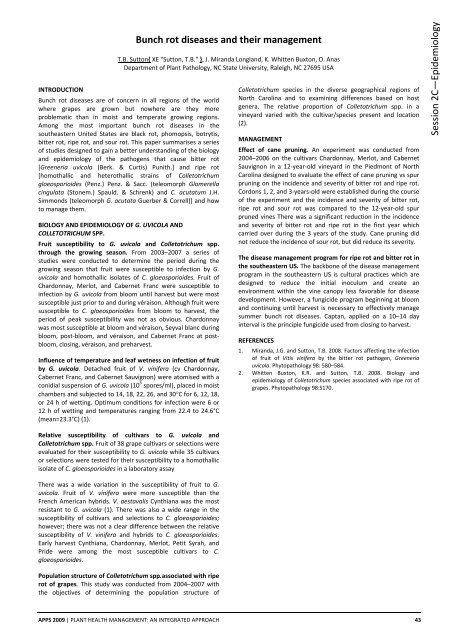View PDF - Australasian Plant Pathology Society
View PDF - Australasian Plant Pathology Society
View PDF - Australasian Plant Pathology Society
Create successful ePaper yourself
Turn your PDF publications into a flip-book with our unique Google optimized e-Paper software.
INTRODUCTION<br />
Bunch rot diseases and their management<br />
T.B. Sutton{ XE "Sutton, T.B." }, J. Miranda Longland, K. Whitten Buxton, O. Anas<br />
Department of <strong>Plant</strong> <strong>Pathology</strong>, NC State University, Raleigh, NC 27695 USA<br />
Bunch rot diseases are of concern in all regions of the world<br />
where grapes are grown but nowhere are they more<br />
problematic than in moist and temperate growing regions.<br />
Among the most important bunch rot diseases in the<br />
southeastern United States are black rot, phomopsis, botrytis,<br />
bitter rot, ripe rot, and sour rot. This paper summarises a series<br />
of studies designed to gain a better understanding of the biology<br />
and epidemiology of the pathogens that cause bitter rot<br />
[Greeneria uvicola (Berk. & Curtis) Punith.] and ripe rot<br />
[homothallic and heterothallic strains of Colletotrichum<br />
gloeosporioides (Penz.) Penz. & Sacc. (teleomorph Glomerella<br />
cingulata (Stonem.) Spauld. & Schrenk) and C. acutatum J.H.<br />
Simmonds (teleomorph G. acutata Guerber & Correll)] and how<br />
to manage them.<br />
BIOLOGY AND EPIDEMIOLOGY OF G. UVICOLA AND<br />
COLLETOTRICHUM SPP.<br />
Fruit susceptibility to G. uvicola and Colletotrichum spp.<br />
through the growing season. From 2003–2007 a series of<br />
studies were conducted to determine the period during the<br />
growing season that fruit were susceptible to infection by G.<br />
uvicola and homothallic isolates of C. gloeosporioides. Fruit of<br />
Chardonnay, Merlot, and Cabernet Franc were susceptible to<br />
infection by G. uvicola from bloom until harvest but were most<br />
susceptible just prior to and during véraison. Although fruit were<br />
susceptible to C. gloeosporioides from bloom to harvest, the<br />
period of peak susceptibility was not as obvious. Chardonnay<br />
was most susceptible at bloom and véraison, Seyval blanc during<br />
bloom, post‐bloom, and véraison, and Cabernet Franc at postbloom,<br />
closing, véraison, and preharvest.<br />
Influence of temperature and leaf wetness on infection of fruit<br />
by G. uvicola. Detached fruit of V. vinifera (cv Chardonnay,<br />
Cabernet Franc, and Cabernet Sauvignon) were atomised with a<br />
conidial suspension of G. uvicola (10 5 spores/ml), placed in moist<br />
chambers and subjected to 14, 18, 22, 26, and 30°C for 6, 12, 18,<br />
or 24 h of wetting. Optimum conditions for infection were 6 or<br />
12 h of wetting and temperatures ranging from 22.4 to 24.6°C<br />
(mean=23.3°C) (1).<br />
Colletotrichum species in the diverse geographical regions of<br />
North Carolina and to examining differences based on host<br />
genera. The relative proportion of Colletotrichum spp. in a<br />
vineyard varied with the cultivar/species present and location<br />
(2).<br />
MANAGEMENT<br />
Effect of cane pruning. An experiment was conducted from<br />
2004–2006 on the cultivars Chardonnay, Merlot, and Cabernet<br />
Sauvignon in a 12‐year‐old vineyard in the Piedmont of North<br />
Carolina designed to evaluate the effect of cane pruning vs spur<br />
pruning on the incidence and severity of bitter rot and ripe rot.<br />
Cordons 1, 2, and 3‐years‐old were established during the course<br />
of the experiment and the incidence and severity of bitter rot,<br />
ripe rot and sour rot was compared to the 12‐year‐old spur<br />
pruned vines There was a significant reduction in the incidence<br />
and severity of bitter rot and ripe rot in the first year which<br />
carried over during the 3 years of the study. Cane pruning did<br />
not reduce the incidence of sour rot, but did reduce its severity.<br />
The disease management program for ripe rot and bitter rot in<br />
the southeastern US. The backbone of the disease management<br />
program in the southeastern US is cultural practices which are<br />
designed to reduce the initial inoculum and create an<br />
environment within the vine canopy less favorable for disease<br />
development. However, a fungicide program beginning at bloom<br />
and continuing until harvest is necessary to effectively manage<br />
summer bunch rot diseases. Captan, applied on a 10–14 day<br />
interval is the principle fungicide used from closing to harvest.<br />
REFERENCES<br />
1. Miranda, J.G. and Sutton, T.B. 2008. Factors affecting the infection<br />
of fruit of Vitis vinifera by the bitter rot pathogen, Greeneria<br />
uvicola. Phytopathology 98: 580–584.<br />
2. Whitten Buxton, K.R. and Sutton, T.B. 2008. Biology and<br />
epidemiology of Colletotrichum species associated with ripe rot of<br />
grapes. Phytopathology 98:S170.<br />
Session 2C—Epidemiology<br />
Relative susceptibility of cultivars to G. uvicola and<br />
Colletotrichum spp. Fruit of 38 grape cultivars or selections were<br />
evaluated for their susceptibility to G. uvicola while 35 cultivars<br />
or selections were tested for their susceptibility to a homothallic<br />
isolate of C. gloeosporioides in a laboratory assay<br />
There was a wide variation in the susceptibility of fruit to G.<br />
uvicola. Fruit of V. vinifera were more susceptible than the<br />
French American hybrids. V. aestavalis Cynthiana was the most<br />
resistant to G. uvicola (1). There was also a wide range in the<br />
susceptibility of cultivars and selections to C. gloeosporioides;<br />
however; there was not a clear difference between the relative<br />
susceptibility of V. vinifera and hybrids to C. gloeosporioides.<br />
Early harvest Cynthiana, Chardonnay, Merlot, Petit Syrah, and<br />
Pride were among the most susceptible cultivars to C.<br />
gloeosporioides.<br />
Population structure of Colletotrichum spp.associated with ripe<br />
rot of grapes. This study was conducted from 2004–2007 with<br />
the objectives of determining the population structure of<br />
APPS 2009 | PLANT HEALTH MANAGEMENT: AN INTEGRATED APPROACH 43







![[Compatibility Mode].pdf](https://img.yumpu.com/27318716/1/190x135/compatibility-modepdf.jpg?quality=85)









